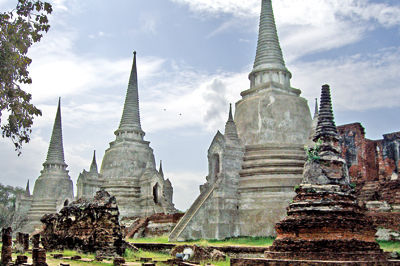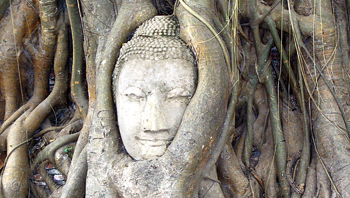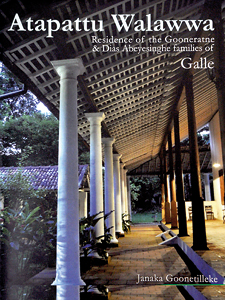Ayutthaya: Ruins tell a tale of a once flourishing Thai city
By Hiranthi FernandoView(s):Variety seems to be the spice of life in Thailand, a country offering a rich diversity of culture, history, entertainment, sports and cuisine as well as landscape to fascinate the visitor. On a recent tour of Thailand, our first destination in Bangkok, was the ancient ruined city of Ayutthaya, (full Thai name,PhraNakhon Si Ayutthaya) about 76 km away. Thailand, like Sri Lanka, has strong links to Buddhism as was evident from the many temples seen everywhere.

Three restored stupas at Wat Si Sanphet
After lunch at Krungsri River Hotel we proceeded to the Historical Park. Our tour guide Poom from Absolutely Fantastic Holidays, a university graduate and Suladda Sarutilavan, Assistant Director of Tourism Authority of Thailand, accompanying us on the tour were very knowledgeable, giving us background information on the way there. Poom said there were 32,000 temples in the country.
The second capital of Siam, the first being Sukhothai, Ayutthaya was founded in 1350 by King U Thong, when the Thais were forced southwards by invading northern neighbours. Earlier it had been a Khmer outpost. The city was named after Ayodhya, the home of Rama in the Indian epic Ramayana.Ayutthaya was the capital of Siam for four centuries, during which period 33 kings and several dynasties ruled the kingdom. The city was eventually sacked by the Burmese in 1767, its treasures looted, ruined and abandoned.
Historical records and ruins show that during its heyday, Ayutthaya flourished as one of South East Asia’s most prosperous cities. Over 400 temples were constructed in the ancient city. Its strategic location between China, India and the Malayan Archipelago, made Ayutthaya the trading capital of Asia. It is said that by 1700, Ayutthaya became the largest city in the world with a total of one million inhabitants. In recognition of its historical and cultural importance, PhraNakhon Si Ayutthaya Historical Park, the location of the ruins, was declared a World Heritage Site by UNESCO in 1991.
Central Ayutthaya is surrounded by three rivers, Chao Praya, Pa Sak and Lopburi, linked by a canal, making it a virtual island. Most of the important sites are located on this ‘island’. Today, few ruins are intact. Walking through the large expanse of the Ayutthaya Historical Park in the searing heat of the early afternoon, we saw roofless columns and crumbling walls and chedis (Thai stupas), sagging steps, piles of bricks and many headless Buddha images.
The remains are all of palaces and temples. Large monasteries with reliquary towers in various stages of collapse are seen scattered over the historic park. Poom says Buddha images were used to decorate temples. Explaining the headless statues, she says most of the ancient images were decapitated by looters to sell to antique collectors.
WatPhraMahathat, meaning great relics, is a historic royal temple located in the centre of the old sacred city. According to historical records, it was built in 1384 during the reign of King BoromRachathirat II, to house a relic of the Buddha. This monastery was once the home of the Supreme Patriarch, a powerful religious force in Ayuthaya. Today the principal pagoda in which the relics were enshrined is a crumbling mass of bricks. The focal point of WatMahathat is the much-visited image of a Buddha head embedded in twisted tree roots by the encroaching forest. Several leaning prangs or towers still stand. According to Poom, the slanting of the towers was aggravated by the severe floods last year. A row of headless Buddha images lined the low walls.

Among the ruins was a Vihara where devotees come in to pray. The ruins of a chapel, distinguished by marker stones at the four corners and in between was also seen. It had a high roof and ventilation slats. Among the ruined buildings was a large Buddha image wrapped in a yellow robe by devotees. A special building known as ‘Vipassana’ with no windows or ventilation was used by the monks to pray and meditate. The monks competed to see who could stay in the room longest. When the monks were in it, someone remained standby by the door. If any monk felt weak or faint, he could knock on the door and be let out.
Another important temple in Ayutthaya is WatPhra Si Sanphet, the largest temple in the complex, and said to be one of the grandest in ancient Ayutthaya. It took its name from the large standing Buddha image built there. It was 16 metres tall and covered with over 150 kg of gold. The statue was smashed and burned to melt the gold when the Burmese sacked the temple. WatPhra Si Sanphet is known for its distinctive row of three restored stupas in typical Ayutthan style. The stupas were built to house the ashes of three kings.Housed within the grounds of the royal palace, this temple was used for royal religious ceremonies. These are just a few of the many ruins of palaces, monasteries and temples which once graced ancient Ayutthaya in its time of glory.
Behind the temple was a typical Thai local market. Small stalls were filled with a wide array of goods. There were intriguing Thai specialties of food; bags of fried pork skin, piles of dried fish, fruit, hot food made on site as well as clothing and footwear. The traders expected one to bargain for their wares.
Another interesting site in Ayutthaya is the floating market. Rows of wooden stalls with a passage in front are built on the banks of a river. One could cross from one side to the other by a bridge or even by boat. A large selection of items are displayed – clothes, shoes, handbags, toys, trinkets and souvenirs at bargain prices. There were all sorts of Thai food and drink. People seated at little wood tables and benches outside the stalls partook of hot soups, fried rice and noodles, hot and iced coffee and chocolate drinks and much more. As the sun went down and darkness enveloped the city, the stallholders gradually closed their shutters and prepared to wend their way home.
(The writer was on a media familiarization tour of Bangkok organized by Cathay Pacific Airlines together with the Tourism Authority of Thailand (TAT).
comments powered by Disqus
















